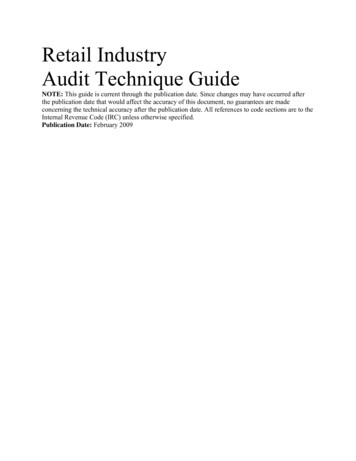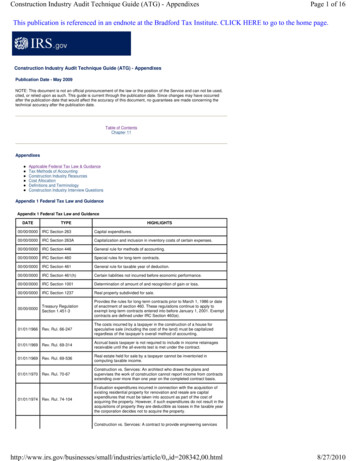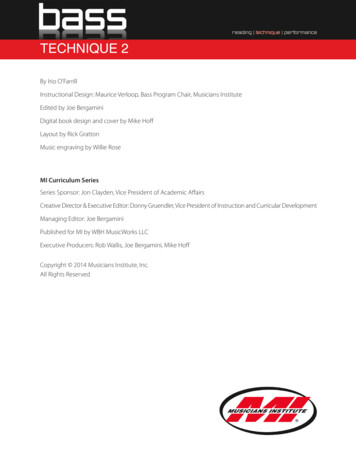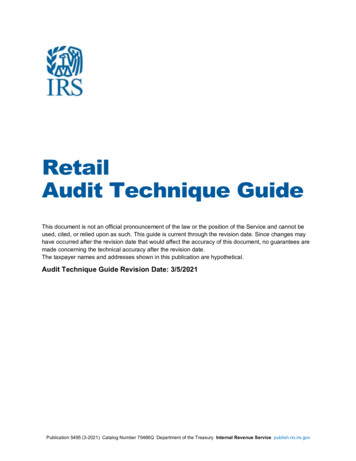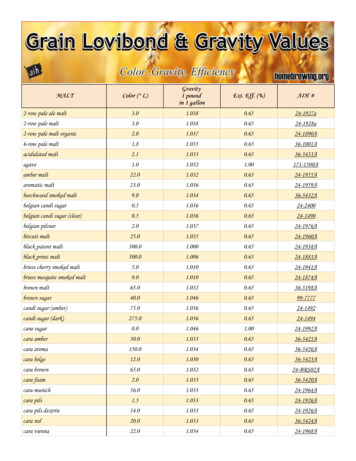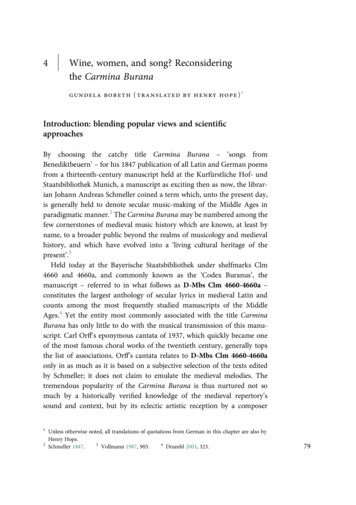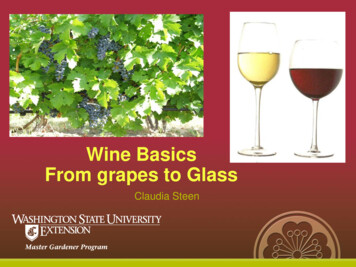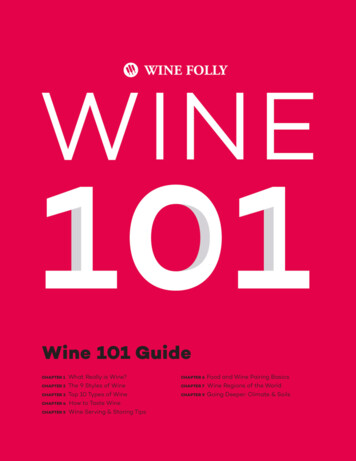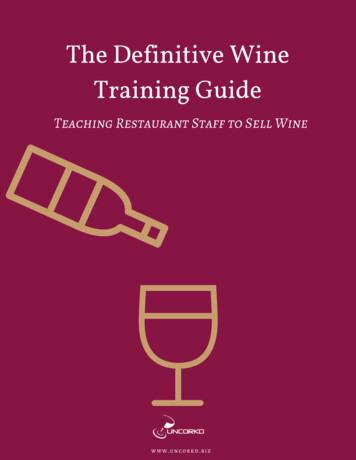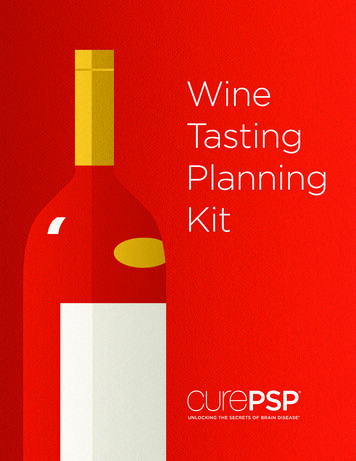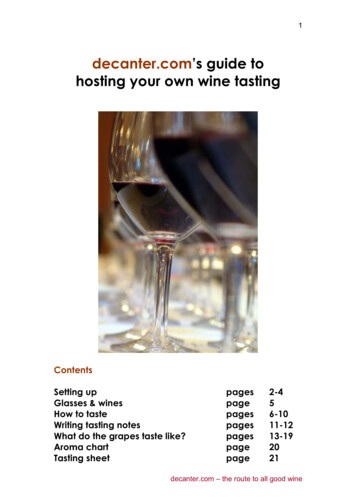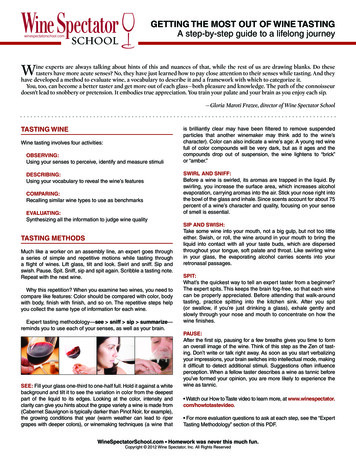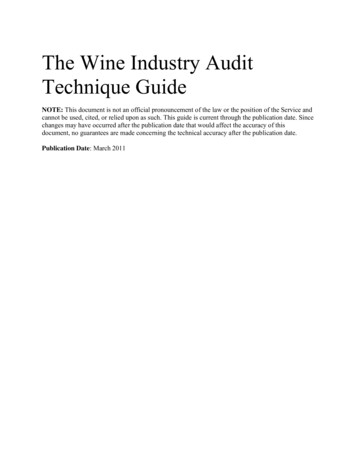
Transcription
The Wine Industry AuditTechnique GuideNOTE: This document is not an official pronouncement of the law or the position of the Service andcannot be used, cited, or relied upon as such. This guide is current through the publication date. Sincechanges may have occurred after the publication date that would affect the accuracy of thisdocument, no guarantees are made concerning the technical accuracy after the publication date.Publication Date: March 2011
Table of ContentsIntroduction . 2Chapter 1 - Overview of Winery/Vineyard Operations . 3Farming . 3Winery (Manufacturing) . 4Marketing/Sales . 6Chapter 2 - Pre-Audit Information Gathering . 8Information Sources. 8Chapter 3 - Audit Considerations . 9Initial Information Document Request . 9Initial Interview and Tour . 9Balance Sheet Accounts . 11Income and Expense Accounts . 12Chapter 4 - Capitalization & Tax Accounting . 15Capitalized Costs Under I.R.C. § 263A “Unicap” . 15Exceptions From I.R.C. § 263A Capitalization . 16Vineyard Operations: Cash And Accrual Methods Of Accounting . 16Vineyard Development Costs . 17Grape Growing Costs And Recognition Of Income – Choice Of Entity . 18Depreciation Methods and Lives . 19Vineyard Emerging Issue . 20Winery Operations . 20LIFO . 22Glossary . 25Information Sources. 33Page 1 of 34
IntroductionThis ATG is intended to be useful to both SB/SE and LB&I examiners in their compliancereviews of both winery and vineyard operations. In addition, it is anticipated that the Industrywill utilize this guide as a resource, as were the previous renditions of the ATG. This guide iscurrent through the publication date. Since changes may have occurred after the publication datethat would affect the accuracy of this document, no guarantees are made concerning the technicalaccuracy after the publication date.This material was designed specifically for training purposes only. Under no circumstancesshould the contents be used or cited as sustaining a technical position.The wine industry has changed in some significant ways over the past 20 years. The Industry hasexpanded substantially. Nationally, there are more than 23,000 farms that grow grapes, withabout 60% of the total production going to wine grapes. The number of wineries has expandedfrom 2,688 in 1999 to over 5,400 by 2007. While almost 90 percent of the U.S. wine productionstill occurs in California, the number of vineyards and wineries in the other 49 states hasincreased dramatically. Another major change has been consolidation and foreign ownership.There are a number of significant developments in tax law affecting the Industry, which will bediscussed in the body of this ATG. Some of these developments have produced wholesalechanges in Industry practices. For example, it was a common practice for a wine producer tohold its related vineyard assets in a separate farming entity. The cash method farmer would sellthe grapes to the winery, but not receive payment until the wine was sold, sometimes 3 or 4 yearslater. This income deferral issue was raised in Oakcross Vineyards, Ltd v Commissioner, T.C.Memo 1996-433; where the Court determined that the cash method of accounting did not clearlyreflect income. Subsequently, it has been held that when a farmer operates as a division of awinery entity, the cash method of accounting for the farming operations is permissible.Therefore, many winery entities are now operating their vineyards as a division of the wineryentity in order to take advantage of the opportunities therein afforded.The IRS has changed significantly as well. The old General Program and CEP distinctions havebeen replaced by SB/SE and LB&I divisions. The Technical Advisor regime was in its infancy20 years ago and has now become a mainstay in issue development. The systems in place forrequesting and receiving guidance have changed significantly.Changes in technology have dramatically changed the way we do business, and likely will bechanging the future as well. Where we used to use fax machines and snail mail, we now use email, thumb-drives and the internet. The popularity of personal computers and sophisticatedspreadsheets has opened the window for increasing the accuracy of LIFO computations byallowing for a more meaningful item definition. We used to work almost exclusively withhardcopy books and records. Now, we often receive the entire set of workpapers electronically.With the advent of encrypted files being shared with the taxpayers, remote audits are morefeasible. Is a virtual tour of the business that far away? Even now, a winery's website has awealth of information to assist the agent in determining the scope of the audit. The AuditPage 2 of 34
Technique Guides now make reference to these website resources rather than include the data inthe guide itself. This enables the examiner to readily access the most current information.Chapter 1 - Overview of Winery/Vineyard OperationsFarmingThe initial step in the making of wine is growing grapes. Specific varieties of grapes are used inmaking premium wines, but any grape with sugar content can be fermented. Successful winegrape farming is dependent upon proper soil and climatic conditions. These particular geographicregions (appellations) can be conducive to the quality of a particular varietal or to wine grapes ingeneral.The first step in the development of a vineyard is land clearing. This may be as simple asplowing under existing vegetation to removal of trees and leveling the dirt. Vineyards planted onhillsides must be terraced. Rocks may need to be removed. Typical water sources include wells,above ground storage (ponds), or some form of irrigation district supply. The water is thendelivered through sprinkler or drip systems.In certain cases, the soil may need to be fumigated (sterilized) prior to planting. Various viral,bacterial, and soil-borne pest problems can be minimized through this process. Fumigationconsists of injecting chemicals into the soil and then sealing the vineyard with a plastic cover fora few days. The cost of this process can vary significantly, depending on the type of chemicalsused and the difficulty in application. In addition to fumigation, the land may need some type ofsoil conditioning, such as the addition of fertilizers, lime, or minerals, to correct deficiencies inthe soil. With the advancing awareness of environmental concerns, soil and water conservationexpenditures are increasingly part of vineyard development costs. Soil and water conservationexpenditures have particular tax consequences and are addressed in the Vineyard section.Grapevines, like most commercial plants, have a disease-resistant rootstock, with a strong fruitbearing varietal grafted on to it. This grafting process is usually done in the nursery (benchgrafting) prior to purchase by the vineyard, but can be done out in the field (field-budding)subsequent to planting. In either case, planting the vines is the next step. A trellis system is thenbuilt for the vines to grow upon. This trellis system allows the foliage to form an “umbrella”(canopy), under which the grape clusters will grow. The type of trellis system will have a majorimpact on vineyard yield (and hence profits). Therefore, many wineries are spending substantialamounts of money on complex trellis systems in the newer vineyards.It takes a period of at least three years from the time of planting for the vines to produce a“commercially harvestable crop”. For tax purposes, this means when the crop is substantialenough where sales proceeds will exceed the cost of harvest. This is an important factor in that itdetermines how long the pre-productive period is and when the vines are “placed in service.”Once the vines are established, there are several cultural practices that occur seasonally. In thedormant season, generally December to February, the vines are pruned. In the spring, the newcanes (vine growth) are trained along the trellis system. Weeding, pest control, fertilization, andPage 3 of 34
mildew/mold control also occurs. Harvest time is August to October. Most premium wine grapesare hand picked, while bulk/generic wine grapes are often machine harvested. A commonpractice for the vineyard owner is to contract out to a farm labor manager who will supply all thelaborers throughout the year. The vineyard manager will pay a flat fee, with the labor managerresponsible for any and all employment tax issues. The deduction will normally be listed as“contract labor.”Another common practice is the planting of a cover crop in the first two years. In the fall anannual cover crop (bell, bean, and oat) is planted and disked in the spring. In the third year apermanent cover crop may be planted in the fall and allowed to reseed in the spring. The covercrop is then mowed once a year.When the grapes are harvested, they must be taken to a certified weigh station. Many winerieswill have a weigh station at their facility. The winery is required to keep certain informationabout their grape supply (whether they grow their own grapes or buy them from others). Thisinformation is captured on a “weight ticket”. The weight ticket will show the tonnage of grapes,the variety of grapes and the vineyard of origin.Audit TechniquesWeight tickets can be very useful in verifying vineyard sales. Accurate grape prices can bedetermined from the Grape Crush Report released by the USDA (see information sources). Thisinformation is available to independently ascertain the gross receipts of a particular vineyardoperation.See Exhibit 1-1 for an overview of the timing of events in the development of a vineyard and thetax treatment of the various costs involved. Some items are capitalized and depreciated, whilesome costs are currently expensed.The University of California Cooperative Extension service provides a review of vineyarddevelopment costs. You may wish to use these estimates to verify the taxpayer's depreciablebasis. You will find sample costs to establish a vineyard as well as an analysis of costs per acre.The agent may utilize the University of California Cost study, which is available under CurrentCost and Returns Studies.Winery (Manufacturing)The process of making wine is a manufacturing process. The winery takes one product (grapes)and transforms it into another (wine). Since this is a manufacturing process, the wineries mustaccount for their costs as a manufacturer using the Uniform Capitalization (UNICAP) rulesunder I.R.C. § 263A. The following discussion of the manufacturing process will also considerhow UNICAP comes into play.Generally speaking, the wine making process has four cost centers: crush/fermentation,aging/storage, general and administrative (G&A), and marketing/sales. Under UNICAP, theprocess of cost accounting should include the following steps. First, all costs must be assigned toPage 4 of 34
the appropriate cost centers. Second, certain G&A costs must be allocated to all the other costcenters. Finally, production costs (crush, fermentation, aging, and bottling costs) must becapitalized to inventory while the balance of costs (remaining G&A and marketing) is deductedcurrently.Depending on the varietal of grape, wine production can take several years when you includebarrel aging and bottle aging prior to the wine's release for sale. Wineries may make severaldifferent levels of wine using different techniques, and many of the people or other costsinvolved in the process cross cost center boundaries. This combination of factors can make costaccounting difficult.Wineries can make several different products. The lower end wine is made in large quantities,usually of lesser quality grapes and using less expensive techniques. This generic wine issometimes used for related products such as brandy, wine coolers or vinegar, but usually is soldas jug or table wine. Premium varietals are the high quality, high priced wines that use thehighest quality grapes. Sparkling wines, commonly known as champagne, need another step inprocessing to give them the effervescence. Brandy is made by distilling wine and aging it anadditional 3 years.The first step in the wine making process is the delivery of the grapes from the fields. The grapesgo into a stemmer/crusher which both separates the individual grapes (berries) from the stemsand leaves, and breaks open the skins. The white wine grapes are then placed in a press, andvarious degrees of pressure can be exerted on the grape skins/pulp to extract more juice.Generally, white wines are made from juice without the skins, while red wines are fermentedwith skins and seeds included.The grape juice is then transferred to a container in which it will be fermented. White wine isoften fermented in temperature controlled, stainless steel tanks. Some premium white varietalsare fermented in the 40 gallon oak barrels in which they will be aged. Red wines are similarlyfermented in stainless steel tanks as the normal practice, but are occasionally fermented in largeopen topped wood tanks.Wines may remain in the tanks in which they were fermented for the balance of their aging priorto bottling. In this case, the tanks see duty as both fermentation and aging tanks. In other cases,the wines, after spending time in the fermentation tank, will be transferred to smaller oak barrelsfor further aging. In either case, the wine in the fermentation tank will be transferred prior to thenext year's harvest, so that the fermentation tank will be available again.All wines take about the same amount of time to ferment (change from grape juice to alcoholicbeverage), but the processing after this step can vary dramatically. Lower end wines aregenerally not aged for any considerable amount of time. However, premium wines are oftenstored in oak barrels (barrel aging) and then bottle aged. For white wines, this aging process cantake from 9 months to 3 years. For red wines, this process can take from 18 months to 5 years.For sparkling wines, the wine must be processed again (yeast and sugar are added to produce thebubbles) and then stored (aged) for a period of time. The total period of time for some sparklingwines, from harvest to completion of the process, can take up to 5 years. The process for brandyPage 5 of 34
is to distill wine into grape brandy designate (GBD) which must be aged in wood barrels for atleast 3 years before it can be marketed as brandy.The definition of “production period” is vital for UNICAP purposes. All the costs associatedwith the manufacturing of the product during the production period must be capitalized toinventory. Any costs incurred after the production period may be deducted as period costs. Priorto UNICAP, some wineries were taking the position, based on the Heaven Hill case, Heaven HillDistilleries, Inc. v. United States, 476 F2.d 1327 (Ct. Cl. 1973) , that the production period forwine stopped when the grape juice was changed into wine. This process takes a matter of weeks.The Service did not agree with this treatment prior to UNICAP. UNICAP requires that theproduction process include aging. One national accounting firm has promoted the concept thatthe production period should terminate at the “release date.” The release date is when the wine isofficially offered to the winery's distribution chain. The Service supports this determination ofthe end of the production period. Prior to the release date, the winery is purposely holding thewine for aging. After the release date, the wine remains unsold only due to sales or marketingrestrictions. Often, a winery will have published release dates for its wines. Barring that, the firstshipping invoice for general sales may be determinative.Wineries will often pre-release wines to wine writers or for other promotional purposes. This isdone for marketing reasons and does not terminate the aging process for that lot of wine. TheService has taken the position that the production period should be determined for each vintage(year the grapes were picked) and varietal (type of wine, based on the type of grape used). Forexample, the production period for a 1988 Chardonnay will be determined separately from a1988 Cabernet Sauvignon.NOTE: TAM 9327007 is an example of the Service's position that the end of the productionperiod is the release date.Marketing/SalesOnce the product is ready for sale, the wineries have a variety of options on how to sell theirproduct. Most wineries have tasting rooms where visitors can purchase the wine directly fromthe winery. The wineries may also sell directly to restaurants and “bottle shops.” Morecommonly, the wineries will work through a broker or a distributor. A distributor will actuallybuy the product for resale. A broker, on the other hand, may take possession but not ownershipof the wine. The broker is paid a commission based on sales. The wineries will still have theirown sales force, even though working through a broker or a distributor. More recently, wineriesare increasingly using their websites as a vehicle to sell their wines directly to the consumer.Some wineries have developed a Wine Club, where subscribers are provided periodic shipmentsof wine, usually at a member's discount.With the proliferation of wineries within the U.S., as well as foreign imports, there is greatcompetition for market share. Therefore, the key to success in the wine industry has fallen on themarketing/promotion side as much as on producing fine wines. To assist in marketing andpublicizing their wines, the winemaker or owner of the winery will often host or attend tastingsor other promotional events. As will be discussed in Chapter 4 (Wine Industry Issues), this canPage 6 of 34
cause cost accounting problems when people “wear more than one hat.” An allocation of theirsalary, based on facts and circumstances, needs to be made.Exhibit 1-1Timing and Treatment of Vineyard Development CostsGuidelines for capitalizing and expensing vineyard establishment costs when UNICAP does notapply. If UNICAP applies, all costs are capitalized until the vineyard starts producing a crop.The following is an example of costs noting C for Capitalize and E for Expense.Cultural CostsFirst YearPre-Plant Tillage: Man and TractorCFumigationCLayout and MarkCDistribute and Set StakesCStakes – 7 foot TreatedCRootstocksCPlanting Vines – LaborCPlanting SupervisionCBud and Cover, Including Rubber TiesCSecond YearThird YearEEBudwood – CertifiedCEUncover and Prune RootstocksCECut Rubbers and Tops, Place CollarsCEEnd Posts – TreatedCCCEnd Posts Set – LaborCCCString Trellis Wire – LaborCCCTrellis WireCCCTrain and Prune – LaborEEMildew ControlEEIrrigation Labor – After PlantingEEEWater & Pumping Power-After PlantingEEEPage 7 of 34
Cultural CostsFirst YearSecond YearThird YearRepairs on Irrigation EquipmentEEECultivationCEEEECCFrost Protection – LaborT-Budding – ConversionCChapter 2 - Pre-Audit Information GatheringInformation SourcesThere are a number of resources available electronically to assist in our initial review of a return,including the winery/vineyard website and various search engines. Larger, publicly tradedcompanies often have a link to their financial statements. Perusing these sources can give awealth of information, including: The name, address, and telephone number of the wineryWhen the winery was foundedWho the principals are, such as the owner, CFO, winemaker, etc.Vineyard holdingsCrush and storage capacityTypes of products (still wine, sparkling wine, brandy)Brand names (if different from the winery name)Recent acquisitions and dispositionsIn some cases, the type of entity (proprietorship, partnership, corporate)Areas and methods of distributionFinancials, including methods of accounting for book.Many wineries are subsidiaries of larger entities and file as part of the consolidated return. Inaddition, some entities may have been acquired by foreign parents. Although tracking ownershipcan be difficult, the ownership of the various entities can be established. Research of industryperiodicals may be required to assist in determining the parent company and where they arelocated. For wineries that underwent a recent change in ownership, information may be obtaineddirectly from the winery, including a copy of their tax return.In addition to finding out information on the winery, the following factors should be evaluatedfor return potential: Who prepared the return? Some CPA firms specialize in the wine industry.Look for obvious omissions in the cost accounting system. Review the cost of goods soldsection to see if it appears that indirect costs have been included.Page 8 of 34
Chapter 3 - Audit ConsiderationsThis chapter provides information in conducting the pre-audit, initial interview, and comparativeanalysis of the balance sheet and income and expense statements.Initial Information Document RequestThe initial Information Document Request (IDR) form should include, in addition to the genericbooks and records, the following items: Schedule M adjustmentsInventory costing workpapersDepreciation SchedulesCopies of all Forms 3115, as changes in method of accounting are commonInitial Interview and TourAs with any examination, the initial interview can be crucial. One of the most difficult aspects ofUNICAP is the allocation of certain costs, especially officer's and employee's salaries. Thetour/walk through of the facilities should be viewed as an opportunity to verify the overheadallocations made. Since the overhead allocations may be made asset by asset or by squarefootage, getting a firm understanding of the layout of the facility is essential.The tour is an excellent time for the taxpayer to tell you about their product line, what varietalsthey produce, what processes they use, and what the different assets are used for.The initial interview and tour may reveal miscellaneous issues. Find out if there are otherstructures on the property that they use to house their vineyard workers or if they are used forother purposes. Find out if the personal residence is on winery/vineyard property. If the residenceis owned by the shareholder, and no other deductions for business use are claimed, no issueexists. However, if title is held by the corporation, depreciation and other associated deductionsmay have been claimed.In addition to all your other standard questions, including those about internal control, you maywish to ask about:Vineyard Operations: Do you grow your own grapes? If so, do you sell any to outside parties? How do youaccount for grape growing costs (deducted versus capitalized to inventory)?Do you purchase grapes from related parties? If so, what are the terms? FMV? Paymentmade in the year of sale or when the wine made from those grapes is sold?Did you buy any vineyard properties recently? (Purchase price allocations - placed inservice dates.)Page 9 of 34
Did you plant or convert (t-bud) any vineyards recently? (T-budding is the grafting in ofa different type of wine grape to the trunk of an existing vine. The issues involve thecapitalization of development costs, including fumigation, cost of vines and trellises,labor, etc.)See Exhibit 1-1.How do you keep track of vineyard expenses? (Deducted versus Capitalized)Did you have any losses due to phylloxera or other disease? Phylloxera is a root lousethat feeds on the roots of vines. The disease kills the vines and the only effectivetreatment is to replace the vineyard.What election have you made concerning I.R.C. § 263A and preproductive costs?If this is a single entity vineyard and winery, how do you account for grapes transferredto the winery operation?Manufacturing Operations: Where are the production facilities? (Some wineries may have several crushing, bottling/warehousing locations.) There are different sourcing relationships with resulting costdifferences to consider.Are the grapes grown and bottled on the winemaker's property? These would be Estategrown.o Are the grapes grown by someone other than the winemaker-bottler and sold tohim directly or in an open market? These are called Open Market Grapes.o Are the grapes that are grown on leased land on a share-profit basis with the landowner? Commonly referred to as Leased Vineyards.How do you account for winery production costs? (How do they keep track of capitalizedvs. deducted costs?)What facilities are used for crush/ferment versus barrel/bottle aging versus postproduction warehousing? (Some wineries have limited storage space and may use a coopof some sort for bottle aging - these costs should be capitalized.)Do you do any custom crush or have any custom crush work done? (Custom crush refersto a winery, which has the idle production capacity doing the crush/ferment and evenbottling/aging for someone who has grapes but not the equipment available. This shouldbe reflected in other income, with an offsetting allocation of costs, by the winery doingthe work. The amounts paid would be capitalized as part of the cost of the wine by theowner of the grapes.)What exactly are the tasks of the highly compensated employees? (Since UNICAPrequires officers' salaries to be capitalized if related to production, it seems that more andmore of their time is accounted for in marketing!)Cost Accounting System: What method do you use? (Are they on UNICAP? Have they tried to avoid UNICAP byusing lower of cost or market? Some wineries have used bulk wine spot prices or otherestimates of fair market value.)Did you have any write-downs of your inventory? (Sometimes a particular tank of winemight in fact go wrong, and the actual sales price might drop below cost. In otherPage 10 of 34
situations, a particular varietal may not be well received, but the sales price may not bereduced. It just takes longer to move the product.)Is there a narrative, manual or other documentation available that discusses how the costaccounting system works? (Often the larger wineries, who have adopted UNICAP willhave a detailed analysis of how they implemented UNICAP - how they allocated thevarious costs between the cost centers.)How do you account for interest expense? (UNICAP requires that interest expense beallocated to inventory having a production period in excess of 2 years, such as most redwines, sparkling wines and brandy.Marketing/Sales Do you do direct sales; use a broker or a distributor or a combination thereof? Are saleslimited to your state or do you sell nationwide or export?Do you maintain your own sales force? Are shareholder/employees or owners involved?(Again, as it relates to UNICAP, the costs involved in marketing and sales are currentlydeductible. A principal shareholder/owner might wear the title of “winemaker” when inreality he or she spends a significant amount of time on the road promoting the wine,leaving the actual production process in the hands of an assistant. Conversely, a guestappearance at a promotional event does not turn a winemaker into a Vice President ofMarketing.)Do you sell any of your wines on futures or sell gift cards?Balance Sheet AccountsInventoriesCompare the balance sheet amounts with prior and subsequent year returns; Schedule A(Computation of Cost of Goods Sold) and the financial statements if available. Are there anydiscrepancies? In one examination, tasting room inventory was included per the financialstatements but excluded from the tax returns. Has the taxpayer changed the inventorycalculations between
The Wine Industry Audit Technique Guide . NOTE: This document is not an official pronouncement of the law or the position of the Service and cannot be used, cited, or relied upon as such. This guide is current through the publication date. Since changes may have occurred after th
